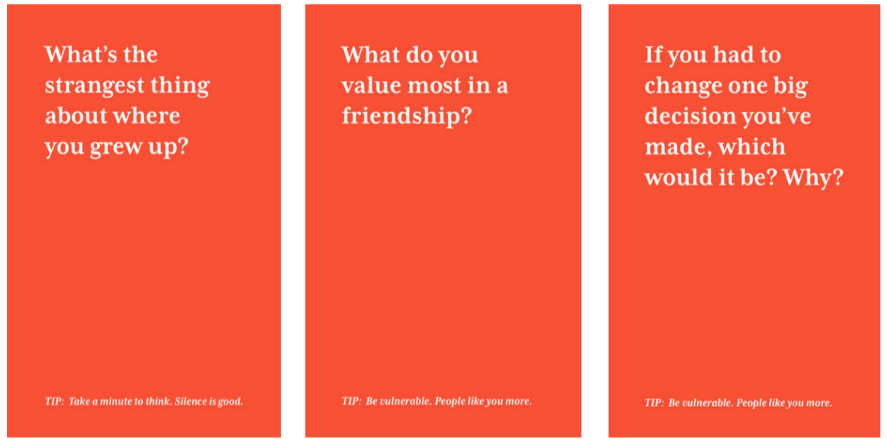Thank you to research partners Charlotte Blank and Russ Frey of Maritz Global Events for your collaboration
The “loneliness epidemic” was a hot topic before Coronavirus hit, but it is even more top of mind now. Loneliness has a UK government department solely devoted to it, whilst nonprofits everywhere are submitting grants for programs designed to prevent it. The subject captures the research imagination because, most likely, we’ve all experienced it ourselves. And — at risk of sounding too technical — it sucks.
What exactly is loneliness?
It is the feeling that your social relationships are not as satisfying as you need them to be (Piquero & Jennings, 2016).
This may look like:
- Before Coronavirus: You’re at home on a Friday night because you couldn’t find someone to go out with. You see on social media that your friends have been hanging out without you.
- During Coronavirus: You’re social distancing with frequent Zoom calls, but you do not really feel supported. You have a bad day and do not have anyone to talk to about it.
These feelings hit a majority of us at some point, and 60% of Americans say they’ve been lonely in the last year. Sadly, loneliness affects some more than others, with 20% of people saying they have no close friends at all (Ballard, 2019). And it matters, since it is likely to increase your risk of death by 29% (Holt-Lunstad & Smith, 2015).

For all the talk about loneliness, research and solutions are lacking.
- Masi et al. (2010) conducted a meta-analysis of 20 randomized studies designed to reduce loneliness; it revealed a small effect size.
- Dickens et al. (2011) reviewed 32 studies on loneliness and concluded ‘there is a need for well-conducted studies to improve the evidence base’.
- Gardiner et al. (2018) looked at 38 studies on older populations and isolation, and they concluded ‘the quality of the evidence base is weak, and further research is required to provide more robust data’.
This is all shorthand for: We know the loneliness epidemic is important, but we cannot find any remedies that work on a meaningful, reliable basis.
Is documenting the severity of this problem really the best we can do? Why are we not finding more solutions to this problem?
It is possible that we are not finding ways to combat loneliness because much of it is deep, structural, and difficult to change. For example, some of the largest causes fall into the “hard-to-change” category:
- Genetics: The estimate of genetic contributions to variation in adult loneliness is 48% (Boomsma & Willemsen, 2005).
- Demographics: Age is inversely associated with loneliness (Schnittker, 2007), in that people tend to become lonelier as they get older. Also, females tend to be more lonely than males.
- Life Circumstances: Having a healthy marriage helps (Olson & Wong, 2001) (Schnittker, 2007), but retirement hurts (Hansson & Briggs, 1990), and so does unemployment (Viney, 1985).
- Cyclical: Lonely people expect rejection, and in so doing, they ruminate on social and interpersonal information to the degree that they feel social anxiety and do not reach out. This becomes a negative feedback loop that’s very hard to get out of (Gardner & Pickett, 2005).
When it comes to loneliness, often all of these factors play a role, and all of them are difficult — some impossible — to change. However, we would like to propose a way to reframe the problem and perhaps come up with some effective remedies.
How can we reframe the problem?
The issue is currently framed as “How can we reduce loneliness?” This helps focus efforts on the group with the highest acute need — typically the elderly — and design solutions to make them less lonely.
For example, the AARP Foundation has million-dollar grant programs for helping lonely seniors. Venture capital is also getting into the game with a reported $25M in the last year invested in startups aimed at engaging older populations. The UK has even asked mailmen to knock on the doors of the elderly to increase social interaction. And obviously these directions are important to explore because they approach the problem where it is the most acute.
Nonetheless, in the same way, that it is easier to prevent cancer than to cure it, here too it may be more productive to focus on loneliness prevention rather than on trying to cure those who suffer the most. If we really want to make a dent in loneliness, maybe the question we should be asking is:
How do we prevent people from becoming lonely in the first place?
As an analogy, if we wanted to decrease the number of people who are obese, we might be tempted to try to help those who are already obese, but a more promising approach would be to deal with the population as a whole to prevent obesity initially. The benefit of prevention in terms of effectiveness is rather obvious, and the benefit becomes even greater when the condition in question, such as loneliness, is a negative aspect of so many people’s lives.
Once we state that our goal is prevention, we can ask how a population gets into trouble in the first place (Morenga & Mallard, 2013). The solution seems simple: The opposite of loneliness is making (and keeping!) friends.
From this perspective, it is not a loneliness epidemic but a lack- of-friendship epidemic, and the solution will have to involve creating high-quality relationships. While this may seem an oversimplification, friendship is a key factor in resolving loneliness.
How Can We Increase Friendship?
To understand friendship, we began by studying conversations, the lifeblood of relationships. Conversations have always been the main building block of friendship, but these days they are more important than ever. In a world full of physical distancing precautions, conversations have become the most crucial ingredient in friendship.
In Aron et al.’s seminal “36 Questions” study, it only took 45 minutes of vulnerable conversation between strangers to make them feel as close as the average relationship in their life (Aron & Melinat, 1997).

The ability of such short conversations to have such an impact on the feeling of closeness has to be one of the most amazing improvements of any social science intervention ever — and one of the best social ROIs for 45 minutes. The key to the large impact of this intervention is that the questions were not all of the “small talk” variety but instead were designed for mutual disclosure — when each person reveals something personal, it encourages closeness.
However, this well-known study was published in the New York Times in 2006, which begs the question:
Why are we not, by now, overwhelmed with close companions? If the recipe for closeness is so well known, why are we not all using it?
The answer lies in our general approach to risk.
As humans, we work very hard to avoid risk in many areas of life, including in our social relationships. Vulnerable conversations, especially with people we do not know well, carry with them a high social risk, and so one must figure out if they should engage and, if so, how to engage.
What is acceptable to discuss? What are the power dynamics in a room? What are the cultural norms? Is social status an issue? Research from Nicholas Eply’s lab (Epley & Schroeder, 2014) supports this assertion by demonstrating that one reason why people do not engage in conversation with strangers is because we fear that the other person will not enjoy it and will reject us.
How can we become close with someone if we’re scared to dive deeper than the latest sporting score or the weather? This is the challenge we need to solve.
Our Studies: How Can We Prompt Deeper Conversations?
We began our investigation with the following hypothesis: In the normal state of affairs, in our regular day-to-day life, if we go too deep and too quickly into a conversation, we break a social norm. To avoid the risk of being that “weirdo” who asks inappropriate questions (the risk), we adopt a strategy of keeping to the lowest common denominator of conversation — small talk — and take no risk, but in return we also receive scant reward. Our team wanted to try to change the paradigm by making deep, less superficial conversation the new normal.
To test this notion, we conducted two experiments in contexts that could not be more different.
Study 1
Irrational Labs, in collaboration with Maritz Global Events, facilitated a series of networking events for one of their client companies, a financial services firm. Imagine six separate groups of about 50 financial advisors each (mostly men, and mostly in suits) sitting down at 9 am to kick off a conference.

At this point, our team gets on stage and provides each group with instructions on how to have networking conversations. Each group then gets started and has conversations according to our rules for the next 45 minutes.
- Just Network: In two of the groups we asked attendees to spend the time networking as they normally would with other attendees.
- Low Guidance: In two of the groups we asked attendees to avoid small talk, but we gave no clear guidance on what they should talk about.
- Strong Rules: For two of the groups we provided conversational cards with probing questions like: “What life experience made you grow the most?” and “What is a compliment you wished you received more?” These groups were required to use these cards to direct their conversation.

What happened?
To get a handle on the effect of these different approaches, we surveyed the financial professionals three times: First, at the start of the conference, second, after the networking activity, and then again at the end of the conference. We discovered people did not like two things: They did not like taking three surveys in a relatively short period of time, but more than surveys, they disliked NOT having clear guidance.
In the standard networking groups and in the groups with the conversational cards, the instructions were clear. In the standard networking groups, people knew what to do, because business people have a particularly good mental model for what is expected of them in a networking session. In the groups with the cards, the participants did not have strong prior knowledge about how to avoid small talk, but the cards and the instructions created a very clear script for what they were expected to do.
However, people in the groups where the only instructions were “not to make small talk” had no script, and so they were left on their own to figure out what to do to break the vulnerability barrier. The end result for this group was more discomfort, lower enjoyment, and fewer new friends.
What implications can we take away from this first finding?
People prefer when social norms are clear, and social norms reduce the cognitive effort of figuring out the appropriate behavior. At a time like the present, when the norms for interaction are in flux, we have an opportunity to create environments that make it clear how people should or should not behave. For example, if we want to create and improve social bonds in these complex Coronavirus times, we could create new scripts and social norms to encourage more meaningful disclosure in unique digital and physical environments.

We also discovered that groups with the conversational cards discussed more topics (on average three more topics) compared to the other groups, and they also discussed themes that are generally considered deeper, like one’s childhood, relationships, plans for the future, or religion.
Yet, somewhat to our disappointment, when we looked at our main outcome of interest, namely, the “likelihood to hang out after the conference,” we did not find any increase in the desire for sustained interaction as a consequence of these more meaningful discussions.
While disappointing, we were not yet ready to toss out the conversational prompts as a possible way to increase friendship. We started this experiment with the full recognition that it might be tough to engage conference attendees fully at 9:00 am as the first agenda item of their financial conference. People came for business purposes, not to make new friends. They were also, to some degree, competitors. Not the ideal place to try to create friendship.
With this in mind, our next experiment was set within a social space (i.e. happy hour) where the mode, context, and expectations were more in line with social exchanges and friendship.
Study 2
Now, picture the laid-back setting of Study 2: Our team hosted six Friday night events, each with about 40 people for a total of 247 attendees. The attendees were recruited from the 20,000 person Meetup group “I want to do that — just not alone.” These were people who, unlike the group in Study 1, were explicitly hoping to meet others and came with the expectation that the evening would include an activity to move their social agenda forward.

This time, we changed not only the people and the setting, but also the focus of the study. We decided to try to learn which conversation topics worked best to drive connection. We assigned attendees to one of three conversation categories:
- Conversations About the Future: Question prompts that asked about one’s future, e.g. “Where do you see yourself in 5 years?”
- Conversations About the Past: Question prompts that asked about one’s past, e.g. “What is something surprising about your childhood?
- Activity: A control 30-minute icebreaker activity, without any conversational prompts. The icebreaker activities were interactive but did not focus on conversation depth. They included short games like blind wine tasting and a challenge to “draw a bicycle” (Lawson, 2006).
Our hypothesis was that talking about your past would increase self-disclosure and, in turn, the likelihood of making a connection. Once again, we found that it is especially useful to test our intuition because again we were wrong (this is why we do experiments).
We found that:
- It did not matter if people discussed their future plans or their past experiences.
- What did matter was if there were conversational prompts to guide the discussion. Although all participants came to the event hoping to increase social connections, the control group was not as successful as their prompt-receiving counterparts.
- With both types of conversation prompts, people revealed more about themselves, felt others revealed more, and talked about more new things than in the control condition.
This mutual disclosure had the intended effect on bonding. On average, people talked to 1.6 more new people and had a higher likelihood of wanting to hang out afterwards in the conversational prompt conditions than in the control condition. Offering a script and setting up a norm for deeper conversation fostered new connections.
Conclusion
What we have on our hands is not a loneliness epidemic but a friendship epidemic. To fix it, we need to figure out how to help people make (and sustain) quality friendships before they become lonely.
While there are many possible ways to encourage friendships, we know at least one path that can help: Having deeper conversations.
Our findings? Instead of allowing people to fall back on the lowest common denominator of conversation, we changed the norms and steered them away from small talk by giving them topics to talk about. Doing this took pressure off the individual, putting the hard task of being vulnerable on the shared social infrastructure, and with it, they also got a high return of social dividends.
We should strive for a world with communities, schools, bars, and neighbors that are designed from the ground up to make it easy and enjoyable to connect. Ideally, the individual never has to feel like they are taking a social risk, and instead, they can follow the pre-existing conversational norm.

Of course, there is still much more research to do on creating socially productive bonds once a norm is set and learning how to strengthen these bonds over time so that they can become real buffers for loneliness. We need to figure out what kinds of people can benefit more and less from this conversational approach to kickstarting friendships. And, where possible, we still want to establish ways to get people to take more social risks on their own, without conversational prompts.
Despite all of these open questions, we end this first step of research with optimism. It is clear that more effort should be invested in preventing loneliness before it starts and that preventing loneliness is a promising direction for both research and for society.
As a final note, we hope all readers take this lesson to heart, by risking a bit more in conversations and reaping the benefits of meaningful social bonds.
If you want a guide for how to start with a script and create the appropriate social norms, check out our No Small Talk conversation cards.
—
References:
Aron, A., Melinat, E., Aron, E. N., Vallone, R. D., & Bator, R. J. (1997). The experimental genera- tion of interpersonal closeness: A procedure and some preliminary findings. Personality and Social Psychology Bulletin, 23(4), 363–377.
Ballard, J. (2019). Millennials are the loneliest generation. Retrieved from https://today.yougov. com/topics/lifestyle/articles-reports/2019/07/30/loneliness-friendship-new-friends-poll- survey.
Boomsma, D., Willemsen, G., Dolan, C., Hawkley, L., & Cacioppo, J. (2005). Genetic and environ- mental contributions to loneliness in adults: The Netherlands twin register study. Behavior Genetics, 35, 745–752.
Dickens, A. P., Richards, S. H., Greaves, C. J., & Campbell, J. L. (2011). Interventions targeting social isolation in older people: A systematic review. BMC Public Health, 11. https://doi. org/10.1186/1471–2458–11–647.
Dykstra, P. A., & Fokkema, T. (2007). Social and emotional loneliness among divorced and mar- ried men and women: Comparing the deficit and cognitive perspectives. Basic and Applied Social Psychology, 29(1). https://doi.org/10.1080/01973530701330843.
Epley, N., & Schroeder, J. (2014). Mistakenly seeking solitude. Journal of Experimental Psychology: General, 143(5), 1980–1999.
Gardiner, C., Geldenhuys, G. & Gott, M. (2018), Interventions to reduce social isolation and loneliness among older people: An integrative review. Health & Social Care in the Community, 26. https://doi.org/10.1111/hsc.12367.
Gardner, W. L., Pickett, C. L., Jefferis, V., & Knowles, M. (2005). On the outside looking in: Loneliness and social monitoring. Personality and Social Psychology Bulletin, 31(11), 1549- 1560.
Hansson, R. O., Briggs, S. R., & Rule, B. L. (1990). Old age and unemployment: Predictors of perceived control, depression, and loneliness. Journal of Applied Gerontology, 9(2), 230–240.
Holt-Lunstad, J., Smith, T. B., Baker, M., Harris, T., & Stephenson, D., (2015). Loneliness and social isolation as risk factors for mortality: A meta-analytic review. Perspectives on Psychological Science, 10(2), 227–237.
Lawson, R. (2006). The science of cycology: Failures to understand how everyday objects work. Memory & Cognition, 34(8), 1667–1675.
Masi, C. M., Chen, H.-Y., Hawkley, L. C., & Cacioppo, J. T. (2010). A meta-analysis of interventions to reduce loneliness. Personality and Social Psychology Review, 15(3), 219–266.
Morenga, L., Mallard, S., & Mann, J., (2013). Dietary sugars and body weight: Systematic review and meta-analyses of randomised controlled trials and cohort studies. BMJ. 346. https://doi. org/10.1136/bmj.e7492.
Olson, K., & Wong, E. (2001). Loneliness in marriage. Family Therapy, 28(2), 105–111.
Perlman, D. & Peplau, L. A. (1982). Theoretical approaches to loneliness. In L. A. Peplau (Ed.), Loneliness: A sourcebook of current theory, research and therapy (pp. 123–134). Hoboken, NJ:Wiley & Sons.
Pinquart, M. (2003). Loneliness in married, widowed, divorced, and never-married older adults. Journal of Social and Personal Relationships, 20(1), 31–53.
Schnittker J. (2007). Look (closely) at all the lonely people: Age and the social psychology of social support. Journal of Aging and Health, 19(4), 659–682.
Viney, L. L. (1985). “They call you a dole bludger”: Some experiences of unemployment. Journal of Community Psychology, 13(1), 31–45.
Article above was featured in the 2020 Behavioral Economics Guide.
